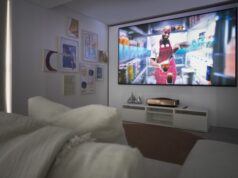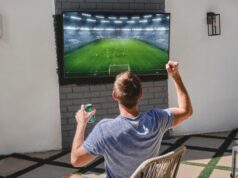
If you’re investing in a projector, it’s also important to consider what you’re going to project it onto, and how that will affect the picture. The right projector screen can make a massive difference to your picture quality.

What is projector screen?
A projector screen is a flat surface used to display video from a projector. Projector screens often use a fabric with a special reflective coating to improve picture quality.
When you project onto a projector screen, light from the projector bounces and reflects back at you. Some people simply use a white wall to display video from their projector, however white walls aren’t able to reflect back as much light, and as result there’s a loss of image sharpness, contrast and brightness in the picture you see.
In order to get the best picture quality from a projector, it’s strongly recommended that you use a purpose-built projector screen. The most popular sizes for home cinema projector screens are typically between 160cm wide and 240cm wide, depending on how far back you intend to sit and how large your room is. The size of the projected image and how far you sit from it will determine how sharp the image is, and it’s important to get the right balance between image size and distance.
How are projector screens used?
Projector screens are most commonly used in home theatre setups, and for presentations or demonstrations. Some projector screens are manually retractable and portable, although to ensure the best possible image quality, home cimena screens are often rigid and either permanently affixed to a wall, or are electronically retractable. Some home cinema projector screens offer the ability to install speakers behind them, which allows for a very directional feel to the audio setup.
What variations exist?
There are four main types of projector screens – these include:
- manual projector screens
- electric projectors screens
- portable projector screens and
- rear projector screens.
Manual projector screens are the cheapest of the bunch, and are easy to install and use. They operate just like a standard roller blind, in that they’re pull down, and retract back up when not in use. Most manual projector screens can be wall or ceiling mounted.
Electric projectors screens are fairly similar to manual screens, in that they can be wall or ceiling mounted, but instead of you pulling them down, an electric motor is used, activated either by a wall switch or a remote control.
Portable projector screens are better suited for those doing presentations or in spaces where a projector is only a temporary fixture. They are easy set up and store when the screen isn’t being used.
Rear projector screens have a special translucent fabric that allows you to project your image onto the screen from behind, instead of in front. These projectors are sometimes used in home theatre setups or for systems where an image is being projected on a screen to be viewed outdoors, and have the added advantage of allowing viewers to walk in front of the screen without disturbing the image.
Projector screens and the moiré effect
In some cases, a projected image may suffer from what’s known as a moiré effect. This is an issue that occurs at a certain distance and resolution, and is a result of the ‘weave’ of the projector screen interfering with the pixels on the display. The solution to resolving this issue often involves replacing your projector screen. If you’re buying a projector screen talk to the sales person about how you can avoid this issue.
What are the alternatives?
In theory a white wall can act as a projector screen, however the quality of the picture won’t be anywhere near as good as that which you’d get with a projector screen.





